PORSCHE CAYNNE 2011 2.G Information Manual
Manufacturer: PORSCHE, Model Year: 2011, Model line: CAYENNE, Model: PORSCHE CAYENNE 2011 2.GPages: 69, PDF Size: 11.14 MB
Page 21 of 69
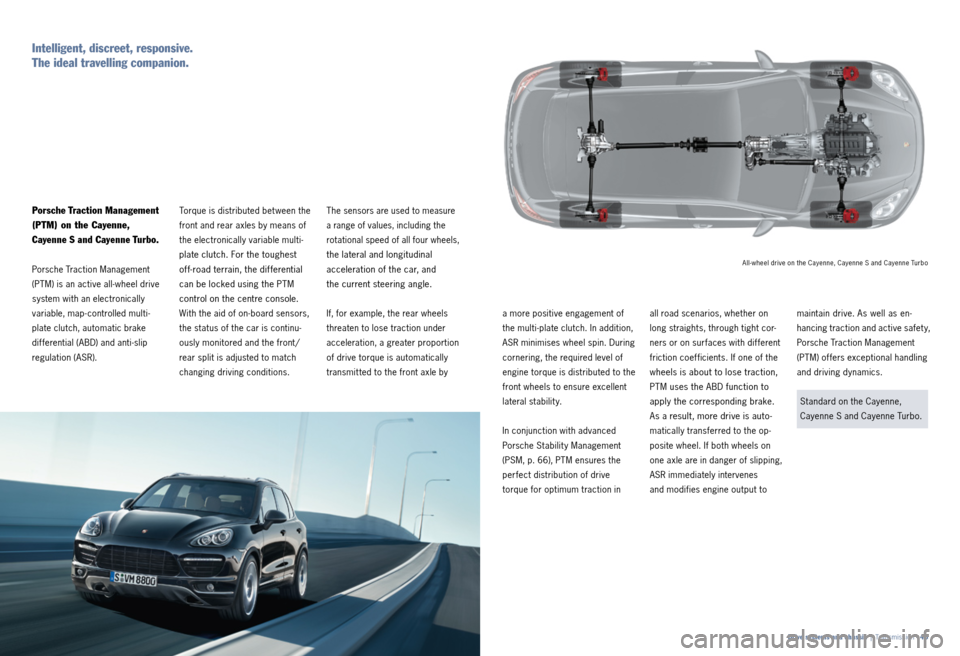
The sensors are used to measure
a range of values, including the
rotational speed of all four wheels,
the lateral and longitudinal
acceleration of the car, and
the current steering angle.
If, for example, the rear wheels
threaten to lose traction under
acceleration, a greater proportion
of drive torque is automatically
transmit ted to the front axle by a more positive engagement of
the multi-plate clutch. In addition,
ASR minimises wheel spin. During
cornering, the required level of
engine torque is distributed to the
front wheels to ensure excellent
lateral stabilit y.
In conjunction with advanced
Porsche Stabilit y Management
(PSM, p. 66), PTM ensures the
perfect distribution of drive
torque for optimum traction in all road scenarios, whether on
long straights, through tight cor-
ners or on surfaces with dif ferent
friction coef ficients. If one of the
wheels is about to lose traction,
PTM uses the ABD function to
apply the corresponding brake.
As a result, more drive is auto -
matically transferred to the op-
posite wheel. If both wheels on
one axle are in danger of slipping,
ASR immediately intervenes
and modifies engine output to maintain drive. As well as en-
hancing traction and active safety,
Porsche Traction Management
(PTM) of fers exceptional handling
and driving dynamics.
Standard on the Cayenne,
Cayenne S and Cayenne Turbo.
Torque is distributed bet ween the
front and rear axles by means of
the electronically variable multi-
plate clutch. For the toughest
off-road terrain, the differential
can be locked using the PTM
control on the centre console.
With the aid of on -board sensors,
the status of the car is continu-
ously monitored and the front /
rear split is adjusted to match
changing driving conditions.
Porsche Traction Management
(PTM) on the Cayenne,
Cayenne S and Cayenne Turbo.
Porsche Traction Management
(PTM) is an active all-wheel drive
system with an electronically
variable, map - controlled multi -
plate clutch, automatic brake
dif ferential (ABD) and anti-slip
regulation (ASR).
Intelligent, discreet, responsive.
The ideal travelling companion.
All -wheel drive on the Cayenne, Cayenne S and Cayenne Turbo
Drive systems and chassis | Transmission · 45
Page 22 of 69
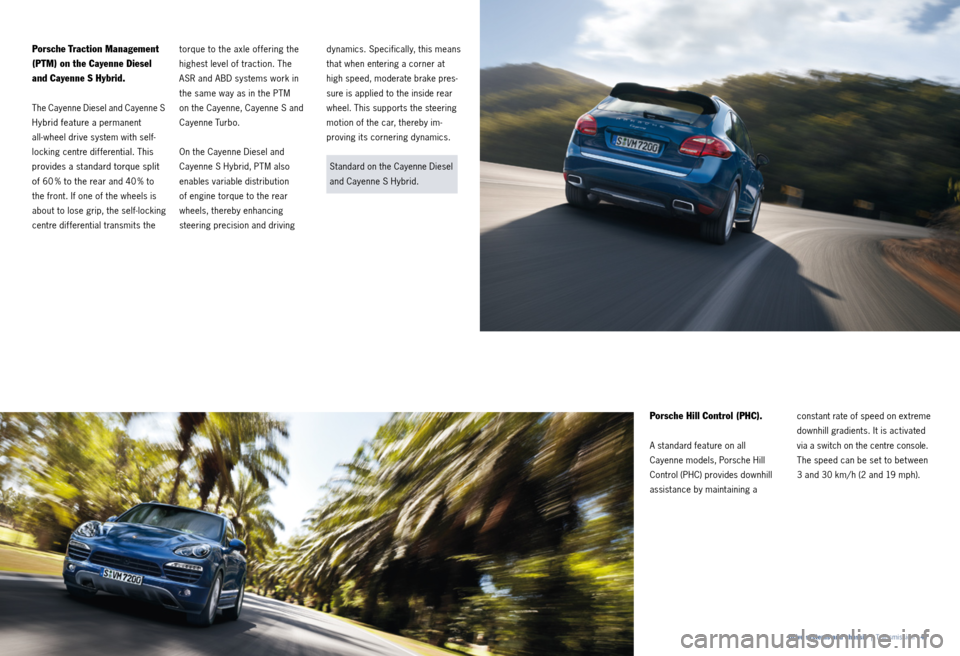
dynamics. Specifically, this means
that when entering a corner at
high speed, moderate brake pres-
sure is applied to the inside rear
wheel. This supports the steering
motion of the car, thereby im-
proving its cornering dynamics.
Standard on the Cayenne Diesel
and Cayenne S Hybrid.
Porsche Hill Control (PHC).
A standard feature on all
Cayenne models, Porsche Hill
Control (PHC) provides downhill
assistance by maintaining a constant rate of speed on extreme
downhill gradients. It is activated via a switch on the centre console.
The speed can be set to bet ween
3 and 30 km/ h (2 and 19 mph).
torque to the axle of fering the
highest level of traction. The
ASR and ABD systems work in
the same way as in the PTM
on the Cayenne, Cayenne S and
Cayenne Turbo.
On the Cayenne Diesel and
Cayenne S Hybrid, PTM also
enables variable distribution
of engine torque to the rear
wheels, thereby enhancing
steering precision and driving
Porsche Traction Management
(PTM) on the Cayenne Diesel
and Cayenne S Hybrid.
T h e C a y e n n e D i es e l a n d C a y e n n e S
Hybrid feature a
permanent
all-wheel drive system with self-
locking centre differen
t ia l. T h is
provides a standard torque split
of 60 % to the rear
and 40 % to
the front. If one of the wheels is
about to lose grip, the self-locking
centre dif ferential transmits the
Drive systems and chassis | Transmission · 47
Page 23 of 69

Available on the Cayenne,
Cayenne Diesel, Cayenne S
and Cayenne Turbo, this function
readies the car for of f-road use
or reverts the set ting to normal
road driving.
In Of f-road Mode 1, for example,
the maps for all relevant
systems, e.g. ABS, are adapted
to provide optimum traction. In addition, High Level I is
selected on vehicles featuring air
suspension with PASM. If that ’s
not enough, the air suspension
can be raised further to High
Level II to increase the approach/
departure angle and wading depth.
Push the of f-road control forward
again on the Cayenne, Cayenne S
and Cayenne Turbo to activate
Off-road Mode 2 – for even great-
er traction on dif ficult terrain,
the multi-plate clutch can be fully
locked.
The electronically variable rear
differential on the optional
Porsche Torque Vectoring Plus
(PT V Plus) is integrated within
the all-wheel drive system. This
automatically ensures the opti-
mum distribution of drive torque on particularly uneven surfaces.
If one of the rear wheels begins
to slip, the rear dif ferential varies
the amount of torque transmit ted
through each drive shaf t, thereby
restoring traction. In Of f-road
Mode 3, the rear dif ferential can
be manually locked using the main
of f-road control. Then both rear
wheels receive the same amount
of torque, regardless of surface
conditions. The optional PDCC
(p. 53) enables greater wheel
articulation in all three modes,
improving traction still further.
For effective prevention of dam-
age to the underside of the car,
all Cayenne models can be
equipped with optional of f-road
underbody protection comprising
rock rails with integrated skid
plates, a reinforced engine-bay
guard, additional protection
for fuel tank and rear axle, and
a second towing lug.
Operating concept.
With the help of Porsche Traction
Management (PTM), the Cayenne
can cope with even the most
demanding of f-road scenarios.
Simply move the main of f-road
control on the centre console
forward or backward to select
one of up to three off-road
modes (depending on the model).
Steep ascents leading to snow-
covered mountain lodges, boggy
ground or muddy, loose surfaces
– all situations that the Cayenne
handles superbly with intelligent
all-wheel drive. The drive systems
featured on the Cayenne models
deliver exceptional torque. For
plent y of power on tap. On any
terrain.
From urban jungle to the windy wilds.
The Cayenne is perfectly at home on any terrain.
Off-road capability.
Drive systems and chassis | Of f- road capabilit y · 49
Main of f- road control
Page 24 of 69
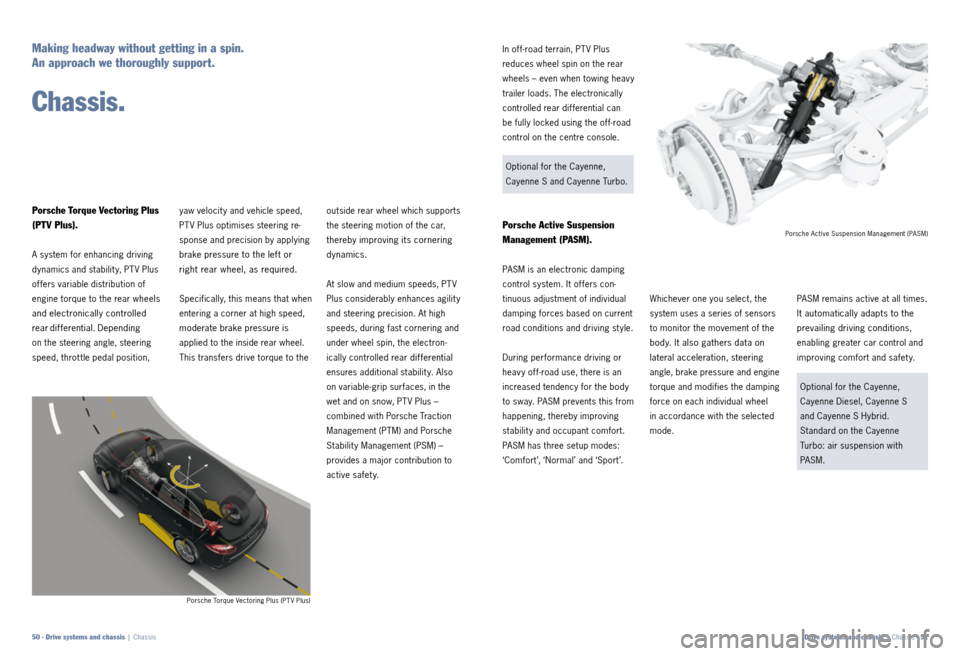
Making headway without getting in a spin.
An approach we thoroughly support.
Chassis.
outside rear wheel which supports
the steering motion of the car,
thereby improving its cornering
dynamics.
At slow and medium speeds, PT V
Plus considerably enhances agilit y
and steering precision. At high
speeds, during fast cornering and
under wheel spin, the electron-
ically controlled
rear differential
ensures additional stabilit y. Also
on variable-grip surfaces, in the
wet and on snow, PT V Plus –
combined with Porsche Traction
Management (PTM) and Porsche
Stabilit y Management (PSM) –
provides a major contribution to
active safety.In of f-road terrain, PT V Plus
reduces wheel spin on the rear
wheels – even when towing heav y
trailer loads. The electronically
controlled rear dif ferential can
be fully locked using the of f-road
control on the centre console.
Optional for the Cayenne,
Cayenne S and Cayenne Turbo.
Porsche Active Suspension
Management (PASM).
PASM is an electronic damping
control system. It of fers con-
tinuous adjustment of individual
damping forces based on current
road conditions and driving st yle.
During performance driving or
heav y of f-road use, there is an
increased tendency for the body
to sway. PASM prevents this from
happening, thereby improving
stabilit y and occupant comfort.
PASM has three setup modes:
‘Comfort ’, ‘Normal’ and ‘Sport ’. Whichever one you select, the
system uses a series of sensors
to monitor the movement of the
body. It also gathers data on
lateral acceleration, steering
angle, brake pressure and engine
torque and modifies the damping
force on each individual wheel
in accordance with the selected
mode.
PASM remains active at all times.
It automatically adapts to the
prevailing driving conditions,
enabling greater car control and
improving comfort and safet y.
Optional for the Cayenne,
Cayenne Diesel, Cayenne S
and Cayenne S Hybrid.
Standard on the Cayenne
Turbo: air suspension with
PASM.
yaw velocit y and vehicle speed,
PT V Plus optimises steering re-
sponse and precision by applying
brake pressure to the left or
right rear wheel, as required.
Specifically, this means that when
entering a corner at high speed,
moderate brake pressure is
applied to the inside rear wheel.
This transfers drive torque to the
Porsche Torque Vectoring Plus
(PTV Plus).
A system for enhancing driving
dynamics and stabilit y, PT V Plus
of fers variable distribution of
engine torque to the rear
wheels
and electronically con trolled
rear differential. Depending
on the steering angle, steering
speed, throt tle pedal position,
Porsche Active Suspension Management (PASM)
50 · Drive systems and chassis | ChassisDrive systems and chassis | Chassis · 51
Porsche Torque Vectoring Plus (PT V Plus)
Page 25 of 69
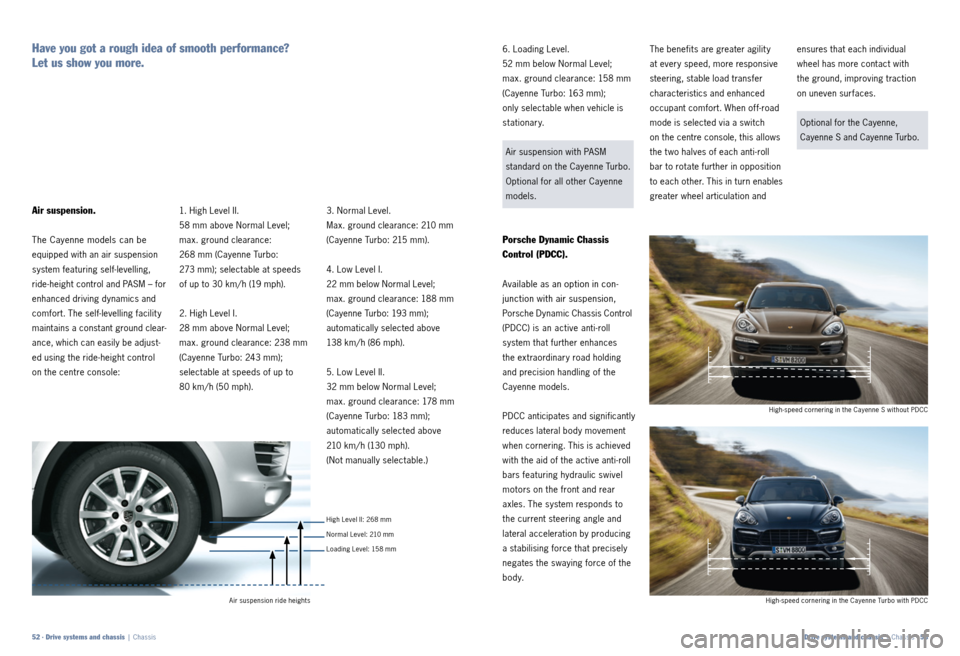
3. Normal Level.
Max. ground clearance: 210 mm
(Cayenne Turbo: 215 mm).
4. Low Level I.
22 mm below Normal Level;
max. ground clearance: 188 mm
(Cayenne Turbo: 193 mm);
automatically selected above
138 km/ h (86 mph).
5. Low Level II.
32 mm below Normal Level;
max. ground clearance: 178 mm
(Cayenne Turbo: 183 mm);
automatically selected above
210 km/ h (130 mph).
(Not manually selectable.) 6. Loading Level.
52 mm below Normal Level;
max. ground clearance: 158 mm
(Cayenne Turbo: 163 mm);
only selectable when vehicle is
stationary.
Air suspension with PASM
standard on the Cayenne Turbo.
Optional for all other Cayenne
models.
Porsche Dynamic Chassis
Control (PDCC).
Available as an option in con-
junction with air suspension,
Porsche Dynamic Chassis Control
(PDCC) is an active anti-roll
system that further enhances
the extra ordinary road holding
and precision handling of the
Cayenne models.
PDCC anticipates and significantly
reduces lateral body movement
when cornering. This is achieved
with the aid of the active anti-roll
bars featuring hydraulic swivel
motors on the front and rear
axles. The system responds to
the current steering angle and
lateral acceleration by producing
a stabilising force that precisely
negates the swaying force of the
body. The benefits are greater agilit y
at every speed, more responsive
steering, stable load transfer
characteristics and enhanced
occupant comfort. When off-road
mode is selected via a switch
on the centre console, this allows
the t wo halves of each anti-roll
bar to rotate further in opposition
to each other. This in turn enables
greater wheel articulation and
ensures that each individual
wheel has more contact with
the ground, improving traction
on uneven surfaces.
Optional for the Cayenne,
Cayenne S and Cayenne Turbo.
1. High Level II.
58 mm above Normal Level;
max. ground clearance:
268 mm (Cayenne Turbo:
273 mm); selectable at speeds
of up to 30 km/ h (19 mph).
2. High Level I.
28 mm above Normal Level;
max. ground clearance: 238 mm
(Cayenne Turbo: 243 mm);
selectable at speeds of up to
80 km/ h (50 mph). Air suspension.
The Cayenne models can be
equipped with an air suspension
system featuring self-levelling,
ride-height control and PASM – for
enhanced driving dynamics and
comfort. The self-levelling facilit y
maintains a constant ground clear-
ance, which can easily be adjust-
ed using the ride-height control
on the centre console:
Have you got a rough idea of smooth performance?
Let us show you more.
High -speed cornering in the Cayenne Turbo with PDCCHigh -speed cornering in the Cayenne S without PDCC
52 · Drive systems and chassis | ChassisDrive systems and chassis | Chassis · 53
Air suspension ride heights
Loading Level: 158 mm Normal Level: 210 mm High Level II: 268 mm
Page 26 of 69
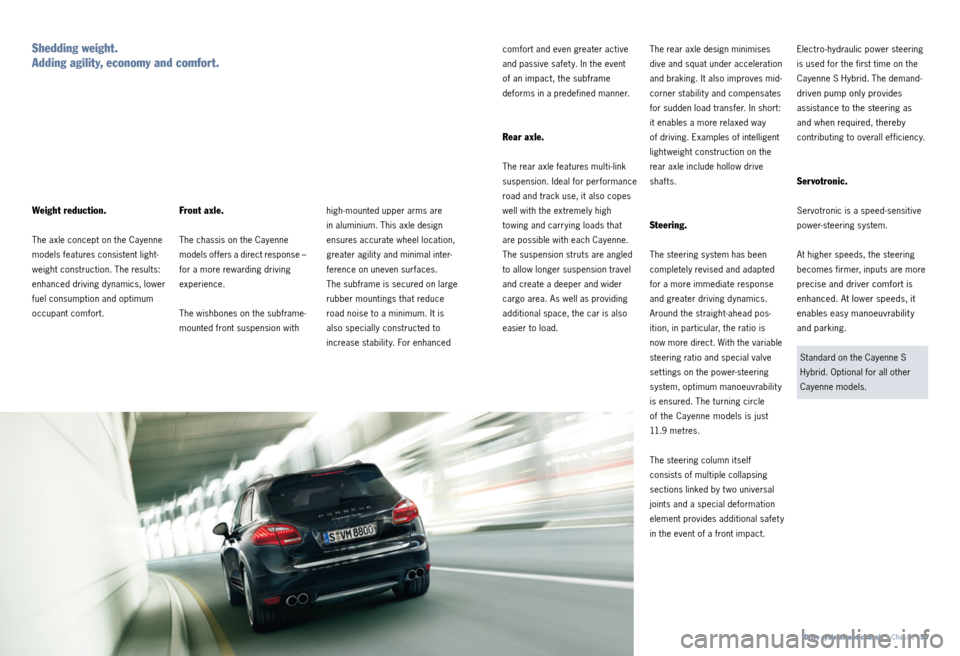
high -mounted upper arms are
in aluminium. This axle design
ensures accurate wheel location,
greater agilit y and minimal inter-
ference on uneven surfaces.
The subframe is secured on large
rubber mountings that reduce
road noise to a minimum. It is
also specially constructed to
increase stabilit y. For enhanced comfort and even greater active
and passive safet y. In the event
of an impact, the subframe
deforms in a predefined manner.
Rear axle.
The rear axle features multi-link
suspension. Ideal for performance
road and track use, it also copes
well with the extremely high
towing and carrying loads that
are possible with each Cayenne.
The suspension struts are angled
to allow longer suspension travel
and create a deeper and wider
cargo area. As well as providing
additional space, the car is also
easier to load.
The rear axle design minimises
dive and squat under acceleration
and braking. It also improves mid-
corner stabilit y and compensates
for sudden load transfer. In short:
it enables a more relaxed way
of driving. Examples of intelligent
light weight construction on the
rear axle include hollow drive
shafts.
Steering.
The steering system has been
completely revised and adapted
for a more immediate response
and greater driving dynamics.
Around the straight-ahead pos-
ition, in particular, the ratio is
now more direct. With the variable
steering ratio and special valve
set tings on the power-steering
system, optimum manoeuvrabilit y
is ensured. The turning circle
of the Cayenne models is just
11.9 metres.
The steering column itself
consists of multiple collapsing
sections linked by t wo universal
joints and a special deformation
element provides additional safet y
in the event of a front impact. Electro -hydraulic power steering
is used for the first time on the
Cayenne S Hybrid. The demand-
driven pump only provides
assistance to the steering as
and when required, thereby
contributing to overall efficiency.
Servotronic.
Servotronic is a speed-sensitive
power-steering system.
At higher speeds, the steering
becomes firmer, inputs are more
precise and driver comfort is
enhanced. At lower speeds, it
enables easy manoeuvrability
and parking.
Standard on the Cayenne S
Hybrid. Optional for all other
Cayenne models.
Front axle.
The chassis on the Cayenne
models offers a direct response –
for a more rewarding driving
experience.
The wishbones on the subf rame-
mounted front suspension with
Weight reduction.
The axle concept on the Cayenne
models features con sistent light-
weight construction. The results:
enhanced driving dynamics, lower
fuel consumption and optimum
occupant comfort.
Shedding weight.
Adding agility, economy and comfort.
Drive systems and chassis | Chassis · 55
Page 27 of 69
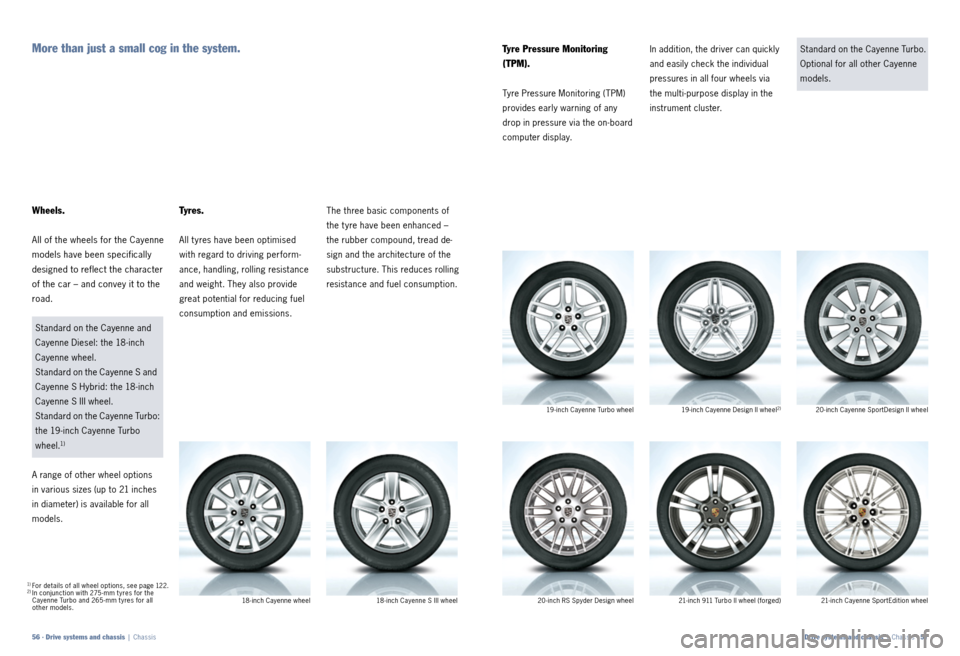
Ty r e s .
All t yres have been optimised
with regard to driving perform-
ance, handling, rolling resistance
and weight. They also provide
great potential for reducing fuel
consumption and emissions. The three basic components of
the t yre have been enhanced –
the rubber compound, tread de-
sign and the architecture of the
substructure. This reduces rolling
resistance and fuel consumption.
Tyre Pressure Monitoring
(TPM).
Tyre Pressure Monitoring (TPM)
provides early warning of any
drop in pressure via the on -board
computer display.
In addition, the driver can quickly
and easily check the individual
pressures in all four wheels via
the multi-purpose display in the
instrument cluster.
Standard on the Cayenne Turbo.
Optional for all other Cayenne
models.
Wheels.
All of the wheels for the Cayenne
models have been specifically
designed to reflect the character
of the car – and convey it to the
road.
Standard on the Cayenne and
Cayenne Diesel: the 18-inch
Cayenne wheel.
Standard on the Cayenne S and
Cayenne S Hybrid: the 18-inch
Cayenne S III wheel.
Standard on the Cayenne Turbo:
the 19 -inch Cayenne Turbo
wheel.
1)
A range of other wheel options
in various sizes (up to 21 inches
in diameter) is available for all
models.
19 - inch Cayenne Turbo wheel
20 - inch RS Spyder Design wheel
18 - inch Cayenne S III wheel 20 - inch Cayenne SportDesign II wheel
18 - inch Cayenne wheel 19 - inch Cayenne Design II wheel2)
More than just a small cog in the system.
21- inch Cayenne SportEdition wheel
21- inch 911 Turbo II wheel (forged)
1) For details of all wheel options, see page 122. 2) In conjunction with 275 - mm t yres for the
Cayenne Turbo and 265 - mm t yres for all
other models.
Drive systems and chassis | Chassis · 57
56 · Drive systems and chassis | Chassis
Page 28 of 69
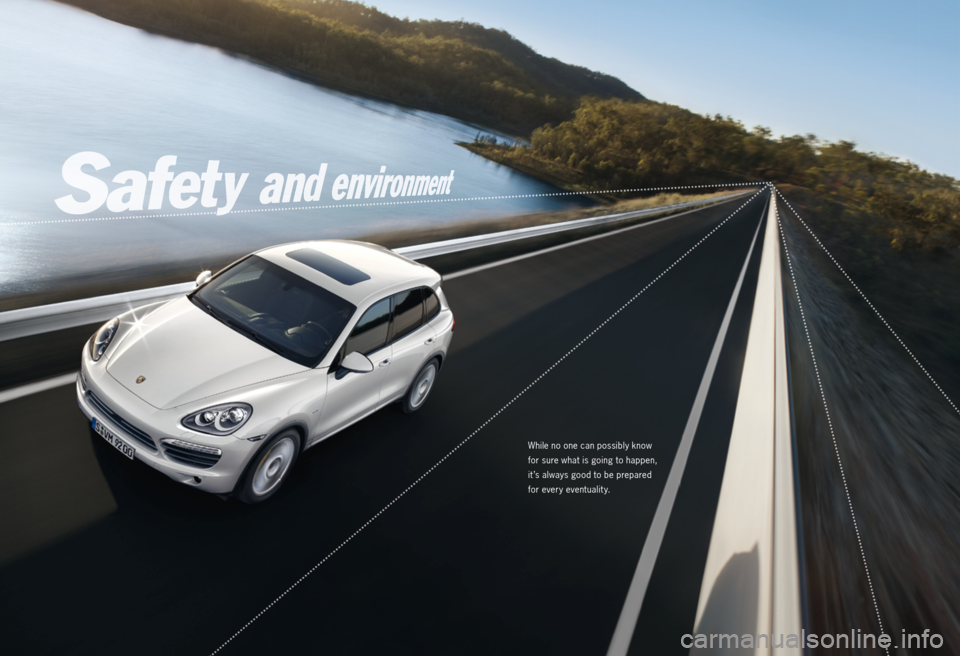
While no one can possibly know
for sure what is going to happen,
it ’s always good to be prepared
for every eventualit y.
Page 29 of 69

Standard on all Cayenne
models.
Halogen main headlights.
The projector-beam halogen main
headlights feature automatic
static range control and reflection
high-beam lights – for optimum
illumination of the road.
Standard on the Cayenne,
Cayenne Diesel, Cayenne S
and Cayenne S Hybrid.
Bi-Xenon main headlights with
Porsche Dynamic Light System
(PDLS).
Featuring halogen auxiliary
headlights, integrated headlight
cleaning and automatic dynamic
range control, the Bi-Xenon main
headlights provide more uniform
illumination of the road in both
dipped and high-beam mode.
The dynamic cornering light
function swivels the main
headlights towards the inside of
a bend
based on the current
steering angle and road speed.
The static cornering lights acti-
vate the auxiliary headlights in order to illuminate more of the
road in tight bends and turns.
PDLS also features speed-
sensitive headlight control and
an adverse weather function,
which is activated in conjunction
with the rear foglight – for even
greater safet y, not just at night
and during cornering.
Standard on the Cayenne Turbo.
Optional for all other Cayenne
models.
Daytime running lights.
Fit ted as standard on all
Cayenne models: LED day time
running lights. On the Cayenne,
Cayenne Diesel, Cayenne S
and Cayenne S Hybrid, these
are arranged horizontally in the front light units, whereas
on the Cayenne Turbo each
main headlight unit has four
LED spotlights. Day time running
lights improve safet y in the
day time as they make you more
visible to other road users.
Taillights.
LED technology is used for all
functions on the rear light mod-
ules. For an ultra-fast response
and greater luminance. In short:
for greater safet y.
In an emergency stop, the
adaptive LED brake lights on
the Cayenne models pulsate
to alert the traf fic behind more
quickly to a critical situation.
The high -level third brake light is
integrated into the roof spoiler.
Automatic headlight activation.
The headlights are automatically
switched on when darkness sets
in or when driving through a tun-
nel in the day time. Other features
include an automatic switch - of f
and ‘Welcome Home’ function –
when you arrive at a destination
after dark, the headlights remain
illuminated for a user- defined
period, lighting your path from
the car.
It ’s always a pleasure taking
corners in a Porsche. Especially when they’re now so visible
at night. The striking lighting
arrangement is also instantly
recog nisable. The lights on the
Cayenne Turbo feature a unique
design that dif fers significantly
from all other models.
Driving with foresight.
Quite literally.
Active safety.
Night design (Cayenne Turbo)
Headlight (Cayenne, Cayenne Diesel,
Cayenne S, Cayenne S Hybrid)
Headlight (Cayenne Turbo)
Safety and environment | Safet y · 61
60 · Safety and environment | Safet y
Page 30 of 69

All Cayenne models have internal-
ly vented discs all round, ensuring
consistent performance during
heav y use. The front disc dimen-
sions (diameter/thickness) are
350 mm/34 mm on the Cayenne
and Cayenne Diesel, 360 mm/
36 mm on the Cayenne S and
Cayenne S Hybrid, and 390 mm/
38 mm on the Cayenne Turbo.All models have six-piston
monobloc aluminium brake
calipers at the front and four-
piston equivalents at the rear.
The calipers are black on the
Cayenne and Cayenne Diesel
and silver on the Cayenne S
and Cayenne S Hybrid. On the
Cayenne Turbo, they feature a
striking red paint finish.
Braking is assisted by a tandem
booster and large brake master
cylinder. Further assistance is
provided by PSM (p. 66).
For greater safet y, the brake pads
are equipped with individual wear
sensors, alerting the driver when
new pads are required.
Electric parking brake.
Manually activated and deactivat-
ed, the electric parking brake
releases automatically as you drive
off.
Automatic hold function.
With the automatic hold function,
you can pull away on the flat or a
slope without ever rolling back.
The system automatically detects
when the vehicle has come to a
halt on an uphill gradient. PSM then
maintains the brake pressure at all
four wheels for a brief period to
prevent the vehicle from moving in
the opposite direction.
Braking systems.
Porsche brakes are renowned
worldwide as the benchmark
in performance and durabilit y.
Equipped with larger and more
powerful braking systems, the
Cayenne models continue this
tradition by offering excellent
deceleration – even when the
car is fully laden with five adult
occupants, a full complement
of luggage and a braked trailer
load of up to 3,500 kg (Cayenne
with manual gearbox: 2,700 kg).
Outstanding brake performance.
To the point.
Standard braking system
(Cayenne/Cayenne Diesel) Standard braking system
(Cayenne S/Cayenne S Hybrid) Standard braking system (Cayenne Turbo)
Safety and environment | Safet y · 63
62 · Safety and environment | Safet y